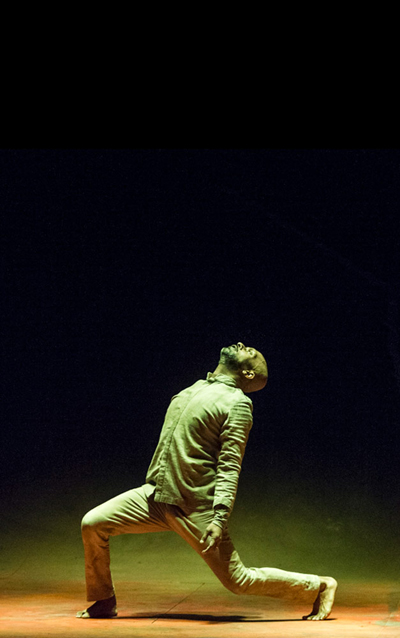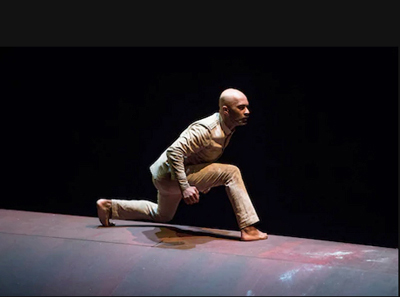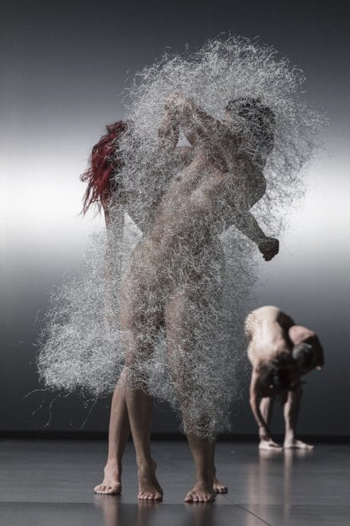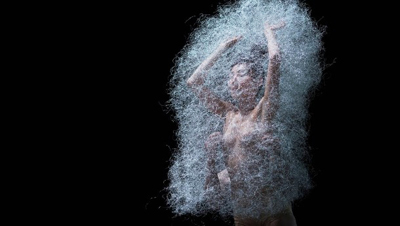Dance: Two Collaborations in Dance — Akram Khan & Sasha Waltz
By Dawn Lille
arttimesjournal December 17, 2018
 Akram Khan in Xenos |
By definition a collaboration is the result of a joint effort by two or more individuals. Many theater artists have been doing this for centuries. Recently two established choreographers shared dances they specifically termed "collaborations."
Akram Khan grew up in London, the son of immigrant parents from Bangladesh. As a boy he trained in Kathak, a form of Indian classical dance with strong rhythmic components and, like all classical Indian dance, a narrative. Later he studied modern dance. Well known as a collaborative choreographer and performer, he has successfully combined both techniques.. He formed his own company in 2000,
Khan's work Xenos, from the Greek meaning "foreign," is a solo performed for two nights as part of Lincoln Center's White Light Festival. Indian music was played by two musicians in front of the subtly-lit stage as one entered the theater. By the time Mr. Khan arrived on stage the audience had become part of an atmosphere in which a story could be readily absorbed.. And Akram Khan, through his choreography, seen in this piece via his singular body, is a story teller!
His tale this time, in which he becomes political, is about the 1.5 million Indian soldiers who fought for Great Britain in the World War One trenches and the xenophobia that existed then and is again rampant. He only recently discovered this bit of history and his 65 minute solo, supported by and integrated with lights, sets and music, made those horrible slashes in the earth eerily visible…
 Akram Khan in Xenos |
After only one viewing I cannot recall any of the steps or patterns, but the vividness of the story remains. Khan's strong and empathetic body, with its changing moods enhanced by Michael Hull's lighting, which seemed to echo the story, as did the evocative music and sound sore by Vincenzo Lomagna.. The set by Mirella Weingarten was chameleon-like in its changes in concert with the lighting..
When the rocks came tumbling into "our" trench at the end one wanted to save Khan's body. He has announced that, at 43, it is the last solo work he will perform .
Sasha Waltz was born in Germany and studied dance and choreography in Amsterdam and New York. An admirer of the post modernists of the New York 80's, she also studied with a student of Mary Wigman She considers her movement vocabulary a mixture of post modern and German expressionist narrative. She founded her own company in 1993 in Berlin, with Jochen Sandig, and created a theater with him as well..
 Sasha Waltz Kreatur |
In an open interview a few nights before her company opened at BAM she spoke of her desire to expand her collaborations. Kreatur, performed by her 14 member troupe as part of the Next Wave Festival, Is her first project with Iris Van Herpen (costumes), Urs Schonebaum (lighting) and Soundwalk Collectiive (music). It was termed "an examination of the human body's … relationship to structures of power."
This program note further describes the work as one that "examines the phenomena of existence [in] … a disrupted society … [of] dominance and weakness, freedom and control, community and isolation."
The costumes were interesting at first - sort of resembling gentle porcupines with spokes of clear plastic projecting from all over the dancer's bodies. They soon discarded this encasement, undressing to a nude-like state in which the women were bare bosomed. It is assumed that Waltz wished to contrast the disguising costume we all wear with our true selves.
The décor included a set of stairs on one side of the stage, which the dancers eventually mounted for no discernable reason. The music used sounds from factories and resonances from landmark buildings.
 Sasha Waltz Kreatur |
The constantly writhing, overly twisted bodies, with many moments of violence and sexual attacks, provoked a negative reaction. But, for this viewer at least, it was not visceral and the result did not feel like a unified whole.
The nomenclature "mixed media" is also a collaboration that has been explored since the 60's.. It became more prevalent with the development of the computer. Merce Cunningham made early use of this. Although the participants in creating his pieces worked separately, by some miracle (Cunningham) at the end they came together. The Ballets Russes (1909-1929) also brought together outstanding artists.
Additionally, many choreographers have enlisted their dancers in the process of creation and have given graphic artists, architects, composers and lighting designers participatory roles. Khan and Waltz will continue in their collaborations, which may or may not be successful, but nevertheless, worth the effort.
dawnlille@aol.com
